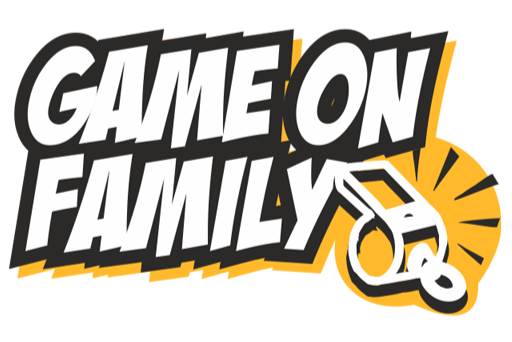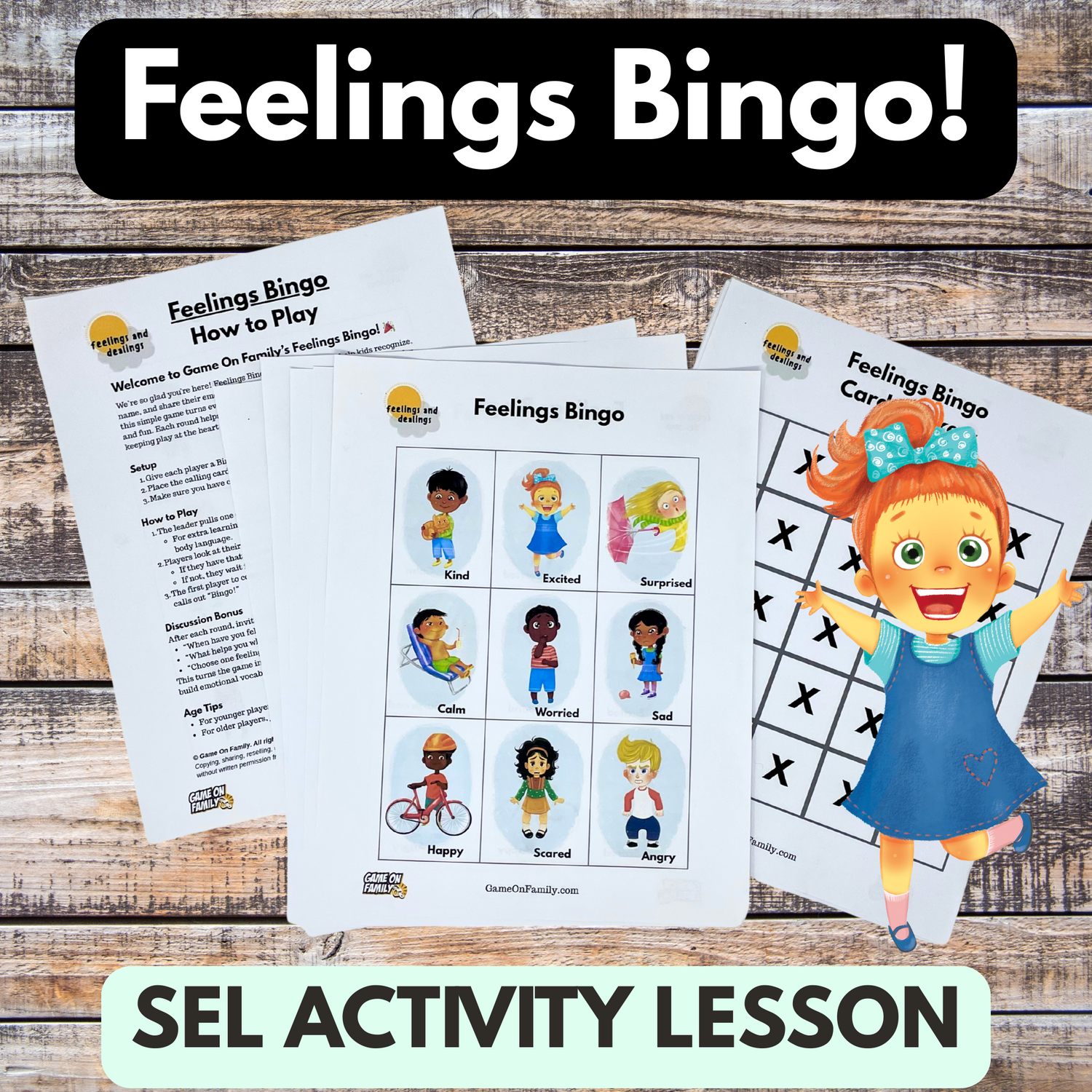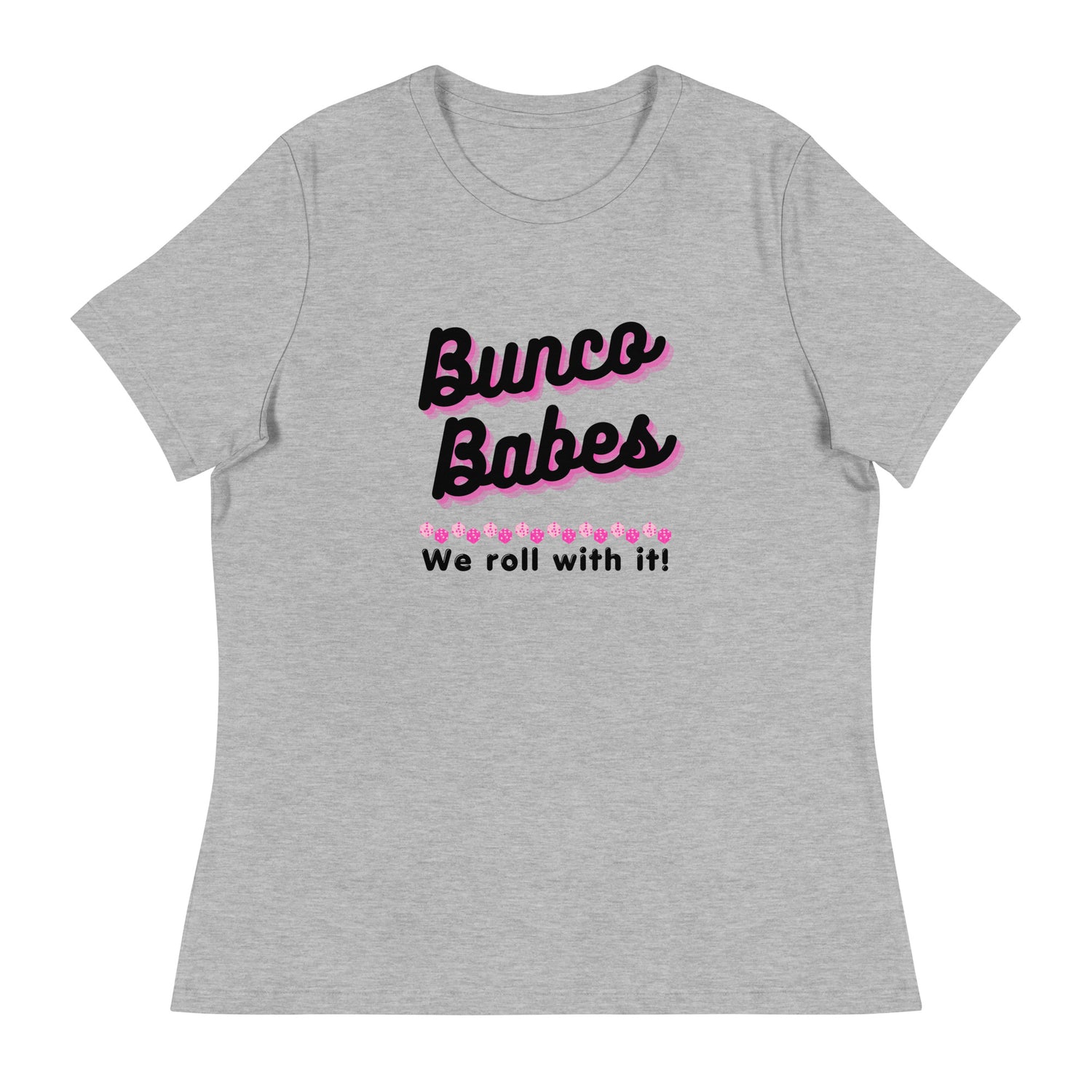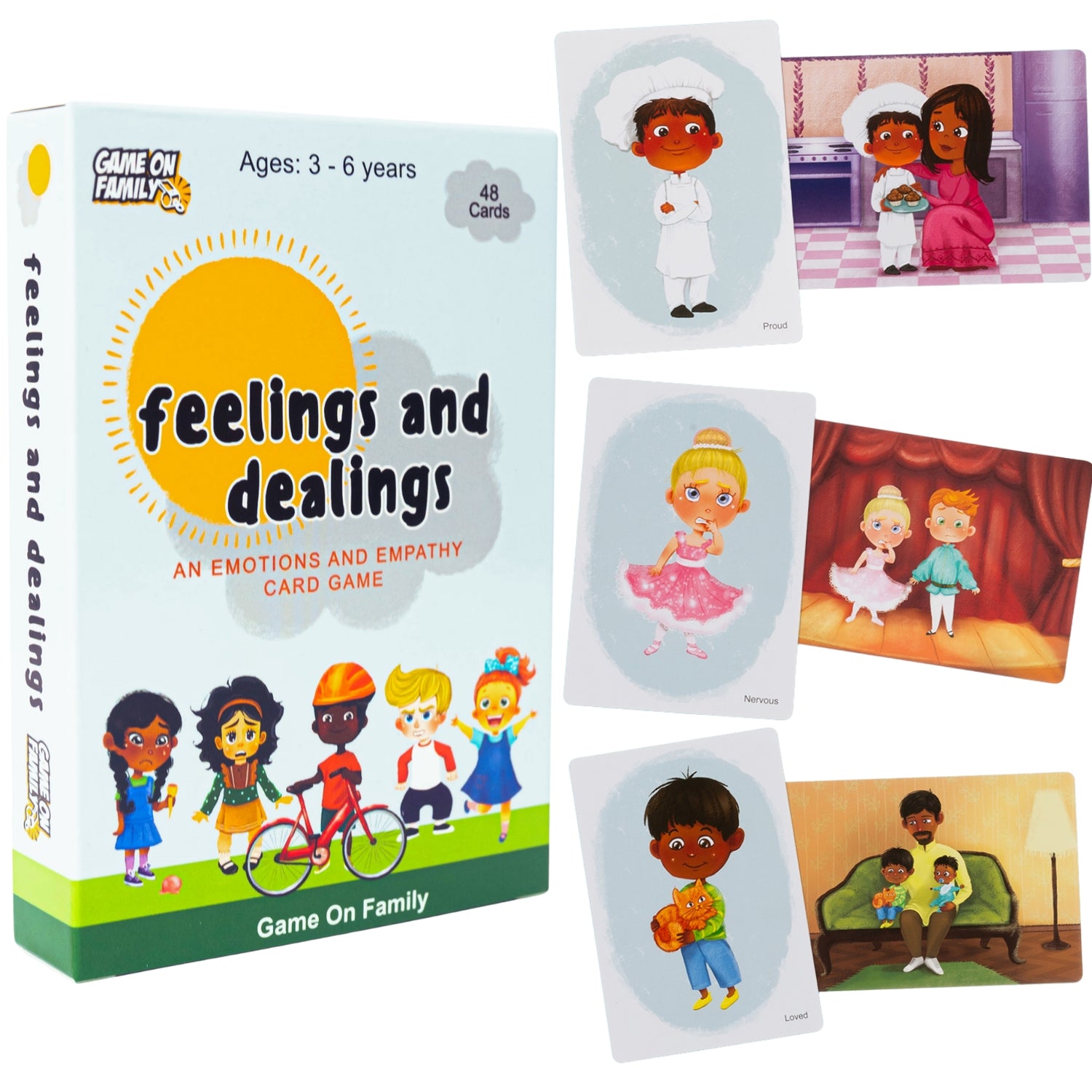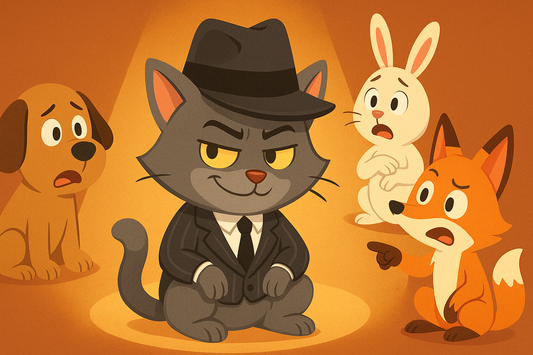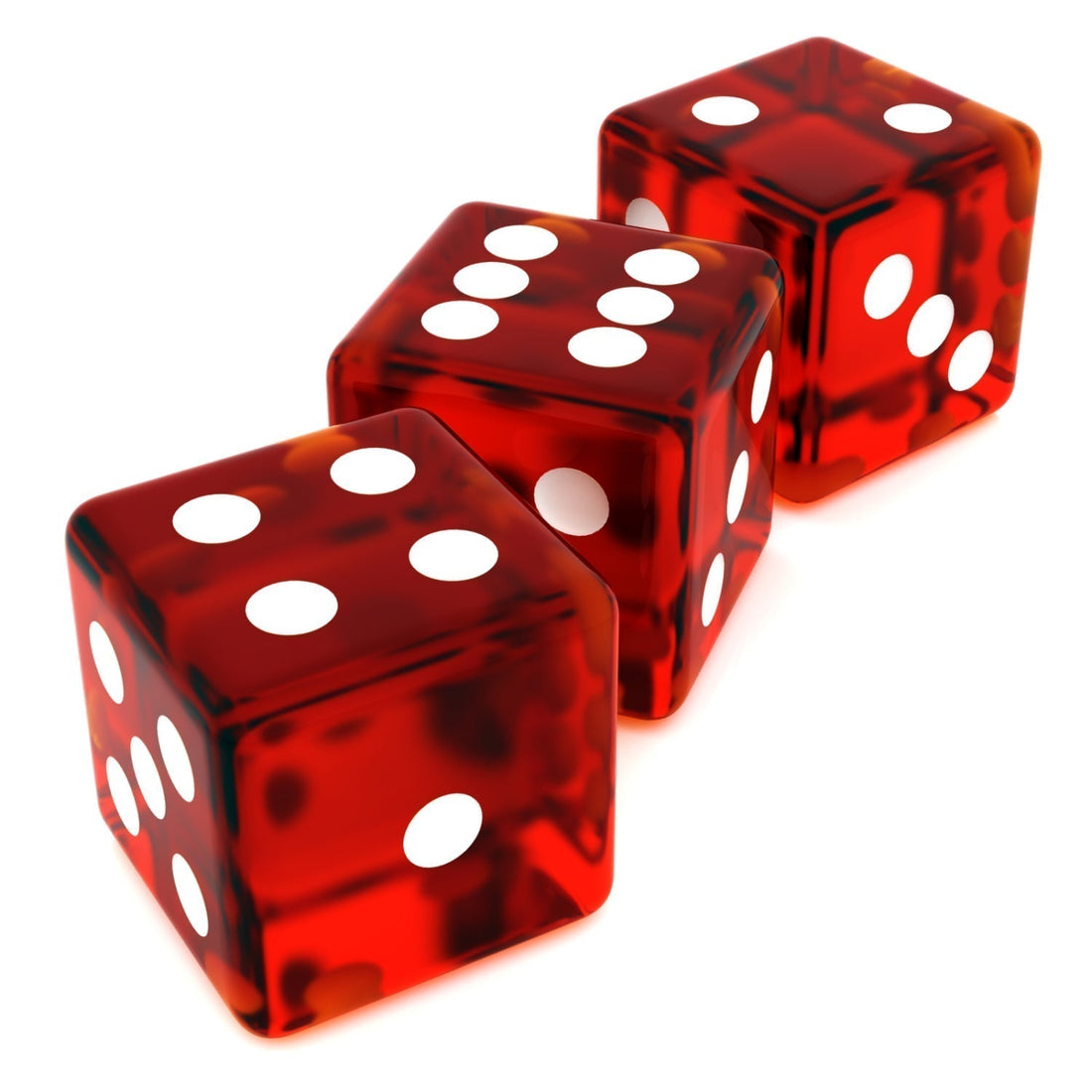
How to Play Bunco
Share
What is Bunco?
Bunco is a fast-moving, social dice game that is played by tens of millions of people every year. It’s usually played with large groups of 12 players, divided into groups of four. Each group of four sits at separate tables and is divided into 2 teams. Teams alternate turns rolling 3 dice to score points and win rounds by outsourcing their opponents. Players rotate tables and teammates every round.
Object of Bunco
The object of bunco is to win more rounds than all other players. Players win rounds when their team scores more points in a round than the opposing team at their table. The individual who wins the most rounds out of all the players is the winner.
What You Need to Play Bunco | Equipment and Gear
Game essentials
- 12 dice / 3 dice per table (or a fancier bunco game set like this)
- 12 score cards (download our free printable scoresheets,, create your own or check out this pack of 100 bunco scorecards on Amazon)
- 12 pencils (these themed pencils are fun)
- 3 table markers (here’s a fun dice themed version)
- 1 bell for the head table (you can do a hand bell like this, or a table bell)
Optional
- Traveling bunco (if you’re doing a prize for the last bunco of the game, this dice bunco traveller is great so they can wear it around their necks)
- Bunco prizes (here's a good start)
- Bunco themed plates and napkins, wine glasses and wine tumblers
- Bunco apparel: shirts, dice earrings, and this ridiculous bunco hat to spice it up
- Or check out the Top Bunco Products on Amazon
Why Bunco is Good for Families and Groups
- Easy to play: The game is comparable to bingo in that it is entirely based on luck. No skill means easy for all!
- Fun: The game moves quickly, is social with constantly rotating tables, and is noisy (dice rolling, talking, and people yelling “BUNCO” and fun!.
- Minimal skills required: math (counting and simple math), taking turns
- Wide age range: 4 and up.
Bunco Game Length
A game of 3-set bunco lasts about 2 hours. That’s 1.5 hours of playing and 30 minutes of setup and breakdown.
How to Play Bunco (Quickstart Guide)
1: Divide 12 players into groups of 4 who sit at 3 separate tables
Provide one scoresheet (or piece of paper) for each player and mark a star on the back of four of them. Pass out the score sheets randomly. The four people who get the marked sheets form the “head table.” Everyone else should form groups of four at the other tables. Don’t worry about picking teammates strategically. Teams switch every few minutes and there it’s also based on luck. If playing with 12 people, the three tables are called the “head” “middle” and “end” tables. With more than 12 players, just number them: Head Table (1), Table 2, Table 3, Table 4, etc.
2: Divide each table of 4 players into teams of 2
The player sitting opposite you is your teammate. The two players on either side of you are your opponents. No need to stress about who is on what team. There is no skill involved in bunco so there are no good or bad players! Plus, teams change often throughout the game.
3: Start and play the first “round” where each player takes “turns” rolling 3 dice to earn “points”
One person per table will be the scorekeeper and that player goes first. Order has almost no strategic advantage, so don’t stress! The first person rolls with the object to score points. Points are only scored in 2 ways:
- The player has one or more dice that match the round number (e.g. rolling 1 in round 1, 2 in round 2, etc). A single match of the round is worth 1 point, a matching pair of the round is worth 2 points, and a triple match of the round is called a “bunco” and has a special bonus value of 21 points.
- The player rolls a matching set of 3 dice of any number other than the round number and earns 5 points. This is also called a “mini bunco.” Example: player rolls three 4s in round 2.
If the roller scores points, their turn continues and they roll again. If they score no points on any roll, their turn is over and it’s the next person’s turn. At the end of each turn, the scorekeeper will add the player's points to their team’s score. The round ends for all tables when a team at the head table scores 21 points. The team at the head table will signal the end of the round by making a noise, such as ringing a bell. At the end or each round, the scorekeeper totals the points for each team. The team with the highest points gets the win and each player will mark a “W” on their scoresheet for that round. Each member of the losing team will mark an “L” on their scoresheet. Also, any individual who rolls a “bunco” during the round will mark that on their individual scoresheet. Example in round 1:
- A single die rolled is a 1 = 1 point
- A pair of dice rolled is a 1 = 2 points
- All three dice rolled are 1s = 21 and are called a “bunco”
- All three dice are any other same number (e.g 2, 2, 2) = 5 points
4: Rotate tables and teammates at the end of each round
It’s social time! At the end of each round, teams switch tables as follows:
- Head table: Winners stay; losers go to the end table.
- Middle tables: Winners move up a table. Losers stay.
- End table: Winners move up a table; losers stay.
Additionally players switch teams every round and it’s really easy to do! Any team that stays at their table moves to sit next to each other to be opponents in the next round. Then the 2 new people to the table just fill the empty seats.
5: Move to the next round and repeat for rounds 2-6 to complete a “set”
Rounds 2-6 are just like round 1, except that the scoring number changes. For example, players must roll 2s in round 2, 3s in round 3, etc. Like in round 1, 1 round-matching die earns 1 point, 2 round-matching dice earn 2 points, 3 round-matching dice earn 21 points, and 3 matching dice of any other number earn 5 points. When round 6 ends, you have completed a “set.”
6: Play the next “set” (usually 2-4 total)
Each round of 6 is considered a “set.” Most bunco nights play 2-4 “sets,” but that can be adjusted up or down depending on the timing. The rules and for the additional sets are the same. Just do another rotation ( table and team) to mix up the teams, then repeat steps 3-5 until you’ve played as many sets as you’d like.
7: Determine the winners of the bunco “game”
The primary winner of a bunco game is the individual player who wins the most rounds. Additional common types of winners can include: most buncos scored, last bunco scored (traveling bunco), as well as highest score, and booby prizes (fewest wins, lowest point score).
8: Award the prizes (optional)
You don’t have to have prizes, but it sure does make it fun! Some groups have every player ante cash (e.g. $5) into a prize pot that’s split across winners. Others provide physical prizes for the various categories above. If there is a tie score for a prize, the tied players can either do a 1 round roll-off to determine the winner, or split the prize (if it’s cash). Check out these Bunco prize ideas on Amazon: Amazon Gift Card, "Winner" Sash, Dice Earrings, Dice Key Chains, Dice Bracelets.
Bunco Video Tutorial
Bunco Rules
Bunco Setup
How many people play bunco?
A standard bunco “party” has 12 players, grouped into fours at separate tables. Each table of 4 is divided into two teams, who sit opposite each other. But the groupings work well in any multiple of four, as 4 people sit at each table. For instructions for odd numbers of players see the FAQ at the bottom of the page.
Tables
In the 12 player version, there are 3 tables of 4 players:
- Head table: Controls the flow of the game. Play for all tables starts when the scorekeeper at the head table starts their 1st turn, and ends when a team at the head table scores 21 points.
- Middle table(s): Any table between the “head” and “end” table.
- End table: The last table.
Note: You can easily have fewer tables (just remove the middle table, or the middle and end table) or more tables (just add more middle tables and number all the tables: 1, 2, 3, 4, etc. to make the flow of the table rotations clear).
Bunco dice
Each table needs 3 dice.
Bunco Variations
We’re outlining the most common bunco setups, but some groups will have variations on number of players, prizes, rotations, and more. As long as it’s clear and fun, go for it! Most variation questions are around the number of players, and we have a detailed guide for every number of players below. To sum it up, adding or removing groups of 4 players is simple: just add or remove a table. For odd numbering situations, you’ll have to make a decision on how you want to handle it. Typically, you have 3 choices: adjust the number of players per table, use a ghost player, or have some number of players sit out each round.
Bunco Scoring
Wins and Rounds
There are 6 rounds in every bunco set, one to match each number on the dice. Rounds continue until someone at the head table scores 21 points. The team with the most points when the round ends wins the round. In case of tie, each of 4 players rolls once and the highest combine team score wins the round. Note: Players at any table other than the head table continue playing until then, even if their points exceed 21 points.
Rolls and Points
There are two ways to score points in bunco:
- One or more of your dice match the the round number (e.g. you roll a 3 in round 3)
- All 3 dice are the same number (All dice are 1s, all are 2s, etc)
Scoring is as follow:
- 1 die matches the round number = 1 point
- 2 dice matching the round number = 2 points
- 3 dice matching the round number = 21 points (this is called a Bunco!)
- 3 dice of same number but don’t match round number = 5 points
Buncos
Any individual who rolls a bunco gets a special “bunco” score mark.
Turns
- Score and continue: Players take “turns” rolling in each round. If the rolling player scores any points in that roll, they continue rolling.
- Don’t score, pass: If the player scores no points during a roll, their turn is over and the player to the left (counterclockwise) starts their turn.
- Keep taking turns until the head table scores 21: Players can have many (or few) turns in each round, depending how quickly or slowly the head table scores 21 points.
Winners and Prizes
Winners
The official winner of bunco is the individual with the most total rounds won. But the larger the group, the more additional consolidation prizes such as: most buncos, traveling bunco, highest score, lowest score, etc. See the FAQ for winner recommendations.
Prizes
Some bunco groups have each player ante into a prize “pot” before play starts, then divide the pot across several winners. Other groups will have physical prized provided by the host. Generally, the bigger the group, the more prizes you can mix in since the pot is larger. For a recommended list of prize splits, see the FAQs.
Ties
If there is a tie for prize winners, you can either do a roll-off round to determine the winner, or, if it’s cash prize and both players agree, then can split the prize.
Other Dice Game You Might Like
Bunco Players FAQ
How do you play bunco with a large group?
Bunco is a perfect game for large groups and it’s easy to add more than the standard 12 players, especially if you add them in multiples of 4 as each table has 4 people. The rules are exactly the same as 12 person bunco, you just add more “middle tables” and number them so the rotations are clear. For example, a bunco game with 20 people would add 2 tables for a total of 5 tables, and number them: Head Table (1), Table 2, Table 3, Table 4, End Table (5). If you have an odd number of players, just do as follows:
- Short 1 to multiple of 4 (e.g. 15, 19, etc): Play with 3 people at the end table. Alternatively, play with 1 “ghost.”
- Short 2 to multiple of 4 (e.g. 14, 18, etc): Play with 2 people at the end table.
- Short 3 to multiple of 4 (e.g 13, 17, etc): Play with 3 people at the 2nd to last table, and 2 people at the end table.
Additionally, with larger groups, it’s fun to mix in additional prizes so there are more winners.
How to play with any number of players?
Multiple of 4: Bunco is easiest to play with any multiple of 4 players (4, 8, 16, 20, etc) since each table will have the desired number of four players. Just add or remove tables.
Odd number: When there is an odd number of players, meaning that you are 1, 2, or 3 players short of a multiple of four, there are several options. Generally, there are 3 options:
- Short play: Some number of tables with fewer than 4 people. (e.g. With 7 people, have 4 at the head table and 3 at the end table).
- Sit out: Have the odd number of players sit out some rounds (e.g. With 9 people, have 1 person sit out each round and adjust the rounds from 6 to 9.
- Ghost: Use a “ghost” player as a replacement. It’s best to use no more than 1 ghost per game, so you don’t end up with weird situations where there are 2 ghosts on the same team. E.g. with 7 players, you add 1 ghost player to get to 8 full tables.
Priorities Our recommendation is to prioritize your choices inn the following order, but how you approach it is up to you and your group:
- No sitting out (short tables over sitting out)
- 2 players minimum at a table
- Seating 4 at a table with the head table as the priority and cascading down
Alternative methods:
- Ghosts.
- Sitting out.
How to play bunco with 1 player?
Bunco is not a game suitable for 1 player. Ideally, you’ll have 4, 8, 12, or some other multiple of 4 players. But there are also ways to play with any combination of 2 or more players.
How to play bunco with 2 players?
A two person game of bunco is possible, although you’re missing out on the social component of rotating teams and tables. Bunco rules for 2 players follow all the same rules of 12 player bunco as outlined above, just skip the table rotations and team switching. The first player to score 21 points first in each round is the winner of that round.
How to play bunco with 3 players?
3 person bunco is best played as individuals. Scoring will be the same, but instead of combining scores, each individual earns their own points. And there will be no table swapping or team switching.
Alternative: You can also play with a “ghost” any time you’re one short of a multiple of 4, as described above,. But for 3 players, individual play is recommended.
How to play bunco with 4 players?
Bunco rules for 4 players is the same as 12-player bunco rules, except you remove the table rotations and play as if the single table is the “head” table. Players still switch teammates each round.
How to play bunco with 5 players?
Five is an awkward number of people, but we recommend you play with 2 tables, with the head table seating 3 players who play as individuals and the end table seating 2 players who play as individuals. The two lowest scorers at the head table rotate down. Both players at the end table rotate up.
Alternatives: Have 1 player sit out each round and adjust your rounds per set to 5 (instead of six. If the round numbers played are different, you can use percentage of wins to determine winners (Wins divided by Rounds played). OR Seat all 5 people at the same table and play as individuals.
How to play bunco with 6 players?
The best way to play bunco with 6 players is to play with 2 tables, with the head table seating 4 player, and the end table sitting 2 players. The head table plays as teams and the end table plays as individuals. The losing team at the head table rotates down to the end table and the winners stay. Both players at the end table rotate up to the head table.
Alternatives: Have 2 tables of 3 players each, all playing as individuals. Or have 2 people sit out each round, but that’s a lot of sitting out!
How to play bunco with 7 players?
The best way to play bunco with 7 players is to play with 2 tables, with the head table seating 4 players and the end table seating 3 playes. The head table plays as teams and the end table plays as individuals. The losing team at the head table rotates down to the end table and the 2 winners stay. The 2 highest scoring individuals at the end table rotate up to the head table, and the lowest player stays.
Alternatives: 7 is actually a great number to play with a ghost. The ghost acts as fake player sitting in the empty seat. The teammate of the ghost player rolls for the ghost, but rolls alternate as if they were a real player. The ghost will rotate tables and teammates just like they would in a normal game of 8.
How to play bunco with 8 players?
8 is a great number of players for bunco, as it’s a multiple of 4. Play as if it's a normal 12 player bunco game. Just remove the middle table and play with a “head” and “end” table.
How to play bunco with 9 players?
9 players is possible in bunco, but as with all player quantities that are 1 extra player over a multiple of 4, it requires the most adjustments. The recommended way to play 9 player bunco is with 3 tables, with the head table seating 4 players who play as teams, the middle table seats 3 players who play as individuals, and the end table seats 2 players who play as individuals. The 2 losers at the head table rotate to the end table and the winners stay, the 2 highest scorers at the middle table rotate up and the lowest stays, and both players at the end table rotate up.
Alternative: Have 1 player sit per round, then increase the rounds per game to 9 rounds so that everyone plays the same numbers of rounds. If the round numbers played are different, you can use percentage of wins to determine winners (Wins divided by Rounds played).
How to play bunco with 10 players?
The recommended way to play bunco with 10 players is to play with 3 tables, with the head table seating 4 and playing as teams, the middle table seating 4 and playing as teams, and the end table seating 2 and playing as individuals. The two losers at the winning table rotate to the end table and the winners stay, the 2 winners at the middle table rotate up and the losers stay, and both players at the end table rotate up.
Alternatives: It’s possible to play with 2 tables of 4 and have 2 players sit out each round, then adjust to 5 rounds so that each player sits 1 round per game. But that’s a lot of sitting! And we don’t recommend playing with multiple ghosts because you can end up with a rotation with 2 ghosts at a table.
How to play bunco with 11 players?
The best way to play bunco with 11 players is to play with 3 tables, with the head table seating 4 players, the middle table seating 4 players, and the end table seating 3 players. The head table and middle tables play as teams and the end table plays as individuals. The losing team at the head table rotates down to the end table and the 2 winners stay. The middle table winners rotate up and the losers stay. The 2 highest scoring individuals at the end table rotate up, and the lowest player stays.
Alternatives: 11 is actually a great number to play with a ghost. The ghost acts as a fake player sitting in the empty seat. The teammate of the ghost player rolls for the ghost, but rolls alternate as if they were a real player. The ghost will rotate tables and teammates just like they would in a normal game of 12.
How to play bunco with 12 players?
12 players is the ideal number of bunko players and is outlined in detail in this guide.
How to play bunco with more than 12 players?
Yes! Bunco is a great game for large groups. It’s especially easy to do in multiples of 4. Since each bunco table seats 4 players, you just add another middle table and follow the normal rules. When you add more tables, it’s helpful to number the tables to keep the rotations clear. For example, if you’re playing bunco with 4 tables, just label them Head table (1), Table 2, Table 3, End table (4). The same goes with more tables. Just keep adding middle tables.
For odd groupings that aren’t multiples of 4, just follow our recommendations for 9 if you’re short 3 players, 10 if you’re short 2 players, or 11 if you’re short 3 players.
Is Bunco a girls' game?
Bunco is great for all genders. It has a reputation as a great game for a “girls night out” or regular social get together because it is a social, fun, and easy to play activity. It’s also a great multi-family game night or mixed game-night.
Bunco General FAQ
What are the origins of Bunco?
The Bunco game started in the 19th century in England – that’s almost 200 years ago! The game was originally called ‘eight dice cloth’ and was introduced to San Francisco as a gambling game in 1855. Today Bunco is a family game that can be played by everyone who knows how to roll a dice!
How many rounds of Bunco do you play?
There are 6 rounds of bunco per set. Most bunco games play 2-4 sets.
How many rolls do you get in Bunco?
It depends! In a given round of bunco you can get one roll (no scoring), many rolls (keep scoring), or none! Once it’s your turn, you continue to roll as long as you score points on the previous roll. And you’ll typically get multiple turns per round. However, a round ends when a team at the head table scores 21 points, which is possibly through regular scoring, or if any individual rolls a bunco and earns 21 points on that one roll. So it’s possible that you don’t even get a single turn to roll in that round!
How do you play Bunco for beginners?
Bunco is a great game for beginners. It’s a social game that’s based entirely on luck. Plus, you’re sitting at a table with 3 other players that can help you through it. The basics are that when it’s your turn to roll, you keep rolling as long as you score points. If you don’t score points on that roll, your turn is over.
Is there any skill in Bunco?
Bunco requires no skill and there is no strategy. It’s entirely based on luck. But, like Bingo, the lack of required skill is what makes it such a successful large group game. Anyone can play!
How do you win at Bunco?
The official winner at bunco is the individual who wins the most rounds by outsourcing the opposing team at their table. Many bunco groups have additional consolation winners, such as the person who rolls the most buncos, the person who rolls the last bunco, and the person with the hightest point total. Larger groups will often mix in additional booby prizes for the player with the least wins or the lowest score.
How do I rotate a table in Bunco?
Table rotations are simple in bunco. At the end of each round, the 2 losers at the head table rotate down to the end table (and the winners stay). For all other tables, the 2 players on the winning teams rotate up a table (and the losers stay).
Additionally, players switch teams every round. So whoever stays at the table become opponents by switching from sitting opposite each other to sitting next to each other. The 2 players arriving at the table just fill the remaining empty seats (also sitting next to each other).
Bunco Equipment FAQ
How many dice are in a Bunco?
Each table needs 3 dice for bunco. A typical game consists of 12 players at 3 tables, so you’d need 9 dice.
What size are Bunco dice?
Bunco dice are just standard dice, numbered 1 through 6.
What is the big dice for in Bunco?
Many bunco groups award a prize for the “traveling bunco,” which is the last person to have rolled a bunco when the game ends. It’s usually played with an oversized set of stuffed dice that a player can wear over their neck. It’s called a “traveling” bunco because as soon as the first person rolls a bunco, they get to wear the set of dice and try to hold on to it until the game ends. But the dice travel to the next person to roll a bunco. It’s especially exciting near the end of the game.
Is Bunco played with 3 dice per table?
Bunco is played with 3 dice per table.
Bunco Parties and Prizes FAQ
To start and plan a bunco night:
1- Get some people together, ideally 12 players or any multiple of 4. For regular games, target a bigger group because not everyone can show every week.
2- Get the equipment. Many people will have a “Bunko box” with all the equipment, as follows:
- 1 Horn/bell to signal the end of each round. It should be loud enough to be heard over all the noise.
- 3 dice per table (and get some extras too)
- Table tents for your table numbers (or just fold a piece of paper and write the number on it)
- Scoresheets: You’ll want some printable scoresheets.
- Scratch paper: Useful for doing some bunco math. :)
- Pencils: Try to have enough pencils for everyone.
3- Have enough tables that can fit 4 players who can sit across from each other.
How many people do you need for a bunco party?
The target number of players for a bunco party is 12 people because there are enough players where the rotations are fun for socializing and you can have multiple prizes. But you can go smaller or larger, ideally in multiples of 4, since there are 4 players per table. If you have an odd number of players, check out the FAQ.
How many prizes do you need for bunco?
The number of bunco prizes depends on the group and the number of players. For small groups (e.g. 4), there is usually 1-2 prizes (most wins, and most buncos / traveling bunco). Groups of 8 will usually have 2-3 prizes. And groups of 12 or more will usually have 3-6 prizes).
Who gets a prize in bunco?
Prizes in bunco vary by how the group decides to structure it. Generally, the bigger the prize, the more winning categories are added.
Some groups have a small ante (e.g. $5 per person) that goes into a pot and it’s split. Other groups rotate hosts and the host purchases physical prizes.
Generally, the main winner is the person who wins the most rounds. The secondary winner is usually the person who rolls the most buncos.
Additional smaller prize winners can include: the player with the highest cumulative score, as well as a “traveling” bunco prize for the person who rolls the last bunco.
Some groups also have booby prizes for: the person with the fewest wins, as well as the player with the lowest cumulative score.
How do you split bunco money?
Prize splits should be determined before play starts. Nothing gets people more riled up than changing the prize rules after the outcome. For physical prizes, instead of percentages, let the top winner select the first prize, and work your way down the list. For cash breakdowns, use the following prize numbers and percentages as a guideline.
4 players:
- Most wins: 60%
- Most buncos (or traveling bunco): 40%
8 players:
- Most wins: 50%
- Most buncos (or traveling bunco): 30%
- Highest cumulative score: 20%
12 players or more players:
- Most Wins: 40%
- Most buncos: 20%
- Traveling buncos: 15%
- Highest cumulative: 15%
- Booby prizes: 10% (e.g. fewest wins and/or fewest cumulative score)
Note: In case of a tie for any of the categories above, players can opt to either do a head-to-head 1-round bunco rolloff where each player gets one turn (continue rolling if last roll scored) and highest score for the round is the winner, OR players can choose to split the prize (only if it’s cash).
What should I bring to a bunco party?
Check with the host about how the group plays. Different groups may expect:
- Money to ante to prize pot
- A shared dish if that’s expected
- Sometimes the host provides the venue and everyone else chips in for food and prizes. Other times the host provides the drinks, or possibly the meal, or possibly the prizes. Just ask! :)
How long does a bunco party last?
A typical, 3 set bunco party lasts 2 hours. Each bunco set is about 30 minutes of playing time. Setup and breakdown (prizes) usually take a combined 30 minutes. So:
- 1 round of bunco = 1 hours (30 minutes of play, 30 minutes setup/breakdown)
- 2 round of bunco = 1.5 hours (1 hour of play, 30 minutes setup/breakdown)
- 3 rounds of bunco = 2 hours (1.5 hours of play, 30 minutes setup/breakdown)
- 4 rounds of bunco = 2.5 hours (2 hour of play, 30 minutes setup/breakdown)
- 5 rounds of bunco = 3 hours (2.5 hours of play, 30 minutes setup/breakdown)
